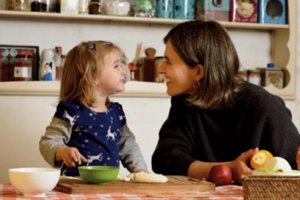Targeting Speech and Language Skills Through Everyday Life
By Stephanie Celaya, CCC-SLP
Kids Place Central Bilingual Speech and Language Pathologist
The first three years of a child’s life is crucial for speech and language development. Their brains are developing and maturing rapidly. It is very important for children to be consistently exposed to environments that are rich in language, sounds, and experiences. Children’s brains are absorbing speech and language through these experiences on a daily basis.
Oftentimes, we hear parents say they struggle to set aside time throughout their day to target their child’s speech and language goals. This is a valid concern considering how families are busy. However, the beauty of speech and language is that they can be targeted anywhere, any time.
The best and easiest way to target speech and language without interrupting your day is to target them during regular daily activities. Some examples include bath time, meal time (at home and/or restaurants), bed time, while dressing, in the car, at the grocery store, and during play. The possibilities are endless!
In addition to not having to interrupt your day by setting aside time to specifically work on their goals, implementing your speech and language goals into daily activities helps children generalize those skills in different settings. When targeting skills solely in a controlled setting (i.e., speech therapy room), children learn the skills there first, and then they still have to practice using those skills in their daily life. If parents implemented practicing speech and language in every-day activities, children are more likely to retain their skills and use their new skills more quickly than if they only practiced it in speech therapy.
Here are a few examples of how parents can target language in different daily activities:
Bath Time Speech and Language Activities
 Labeling objects (i.e., shampoo, water, cup, sponge, toys, etc.). Parents can model by holding up an object and naming the object(s). The word can then be used in a sentence as well (i.e., The duck is in the water.).
Labeling objects (i.e., shampoo, water, cup, sponge, toys, etc.). Parents can model by holding up an object and naming the object(s). The word can then be used in a sentence as well (i.e., The duck is in the water.).- Labeling actions: Talk about what is happening during the bath. Use words like “pouring,” “washing,” “swimming,” “squeezing.” You can use these actions in sentences (i.e., The duck is swimming in the water.).
- Using adjectives: Describe how things feel or look in the bath. Is the bath hot or cold? Is the toy big or small? Is the soap slippery or rough?
- Questions: You can ask questions about your child’s day (i.e., What did you eat for lunch? What did you play at recess?)
- Bath books: Bath books are a great way to target labeling objects and actions while looking through the book. You can also follow 1-step directions (turn the page, point to the dog).
Bed Time Speech and Language Activities:
 Reading is one of the best ways to target language development, and bed time is the perfect time. Parents can use picture books and make up the story as they go, asking the child to help. If your book is very wordy, you can make up your own story by describing what the characters are doing.
Reading is one of the best ways to target language development, and bed time is the perfect time. Parents can use picture books and make up the story as they go, asking the child to help. If your book is very wordy, you can make up your own story by describing what the characters are doing.
- Name objects seen in pictures.
- Answer questions (who, what, where)
- Retelling parts of the story
- Sequencing: children can talk about steps in their bedtime routine (i.e., First we put on our pajamas, then we brush our teeth, last we read a book). They can also sequence parts of a story.
- Body parts: parents can have children identify body parts (Where are your eyes? Show me your nose) and name body parts (i.e., parents point to a body part and ask the child what it is called).
- Singing: parents can sing lullabies during bed time. There is strong evidence that singing can support language development.
Meal Time Speech and Language Activities:
 Name the foods they are eating.
Name the foods they are eating.- Give your child a little bit of food/snack, which encourages them and gives them an opportunity to ask for “more.”
- Describe foods (temperature, texture, size, taste, colors)
- Involve them in meal prep. Cooking is really fun and there are tons of opportunities to target language while cooking (following directions, naming objects/foods, naming actions).
- Following directions while setting the table (give me the fork, put your plate on the table).
In addition to directly targeting things like labeling, actions, directions, questions, and sounds, parents can indirectly help by narrating everything they’re doing throughout their day. This indirect approach also significantly helps develop speech and language skills!


 Labeling objects (i.e., shampoo, water, cup, sponge, toys, etc.). Parents can model by holding up an object and naming the object(s). The word can then be used in a sentence as well (i.e., The duck is in the water.).
Labeling objects (i.e., shampoo, water, cup, sponge, toys, etc.). Parents can model by holding up an object and naming the object(s). The word can then be used in a sentence as well (i.e., The duck is in the water.). Reading is one of the best ways to target language development, and bed time is the perfect time. Parents can use picture books and make up the story as they go, asking the child to help. If your book is very wordy, you can make up your own story by describing what the characters are doing.
Reading is one of the best ways to target language development, and bed time is the perfect time. Parents can use picture books and make up the story as they go, asking the child to help. If your book is very wordy, you can make up your own story by describing what the characters are doing.
 Name the foods they are eating.
Name the foods they are eating.




